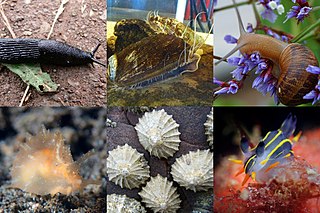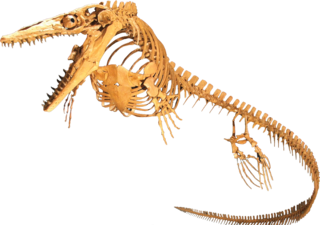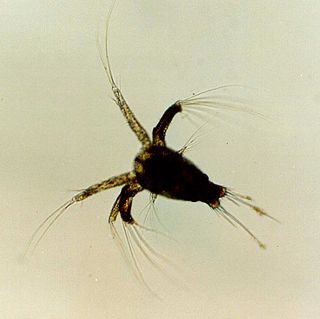
Gastropods, commonly known as slugs and snails, belong to a large taxonomic class of invertebrates within the phylum Mollusca called Gastropoda.

Mosasaurs are an extinct group of large aquatic reptiles within the family Mosasauridae that lived during the Late Cretaceous. Their first fossil remains were discovered in a limestone quarry at Maastricht on the Meuse in 1764. They belong to the order Squamata, which includes lizards and snakes.

Goniatids, informally goniatites, are ammonoid cephalopods that form the order Goniatitida, derived from the more primitive Agoniatitida during the Middle Devonian some 390 million years ago. Goniatites (goniatitids) survived the Late Devonian extinction to flourish during the Carboniferous and Permian only to become extinct at the end of the Permian some 139 million years later.

Bathyuriscellus is an extinct genus from a well-known class of fossil marine arthropods, the trilobites. It lived during the Botomian stage, which lasted from approximately 524 to 518.5 million years ago. This faunal stage was part of the Cambrian Period.
Sajanaspis is an extinct genus from a well-known class of fossil marine arthropods, the trilobites. It lived during the Botomian stage, which lasted from approximately 524 to 518.5 million years ago. This faunal stage was part of the Cambrian Period.
Atdabanella is an extinct genus from a well-known class of fossil marine arthropods, the trilobites. It lived during the early part of the Botomian stage, which lasted from approximately 524 to 518.5 million years ago. This faunal stage was part of the Cambrian Period.
Poliellina is an extinct genus from a well-known class of fossil marine arthropods, the trilobites. It lived during the early part of the Botomian stage, which lasted from approximately 524 to 518.5 million years ago. This faunal stage was part of the Cambrian Period.
Metaredlichia is an extinct genus from a well-known class of fossil marine arthropods, the trilobites. It lived during the early part of the Botomian stage, which lasted from approximately 524 to 518.5 million years ago. This faunal stage was part of the Cambrian Period.
Kuanyangia is an extinct genus from a well-known class of fossil marine arthropods, the trilobites. It lived during the early part of the Botomian stage, which lasted from approximately 524 to 518.5 million years ago. This faunal stage was part of the Cambrian Period.
Labradoria is an extinct genus from a well-known class of fossil marine arthropods, the trilobites. It lived during the early part of the Botomian stage, which lasted from approximately 524 to 518.5 million years ago. This faunal stage was part of the Cambrian Period.
Arthricocephalus is an extinct genus from a well-known class of fossil marine arthropods, the trilobites. It lived during the later part of the Botomian stage, which lasted from approximately 524 to 518.5 million years ago. This faunal stage was part of the Cambrian Period.
Megapalaeolenus is an extinct genus from a well-known class of fossil marine arthropods, the trilobites. They lived during the later part of the Botomian stage, which lasted from approximately 524 to 518.5 million years ago. This faunal stage was part of the Cambrian Period.

Parapaokannia is an extinct genus from a well-known class of fossil marine arthropods, the trilobites. It lived during the later part of the Botomian stage, which lasted from approximately 524 to 518.5 million years ago. This faunal stage was part of the Cambrian Period.
Pseudichangia is an extinct genus from a well-known class of fossil marine arthropods, the trilobites. It lived during the later part of the Botomian stage, which lasted from approximately 524 to 518.5 million years ago. This faunal stage was part of the Cambrian Period.
Megalaspidella is an extinct genus from a well-known class of fossil marine arthropods, the trilobites. It lived during the later part of the Arenig stage of the Ordovician Period, approximately 478 to 471 million years ago.

Megalaspides is an extinct genus from a well-known class of fossil marine arthropods, the trilobites. It lived during the later part of the Arenig stage of the Ordovician Period, approximately 478 to 471 million years ago.
Nozamichthys is an extinct genus of ray-finned fish that lived during the late Moscovian stage of the Pennsylvanian epoch in what is now Illinois, United States. Fossils were collected from the Mazon Creek fossil beds. The first part of the genus name is Mazon spelled backwards, and the second part means 'fish'.

Crustaceans may pass through a number of larval and immature stages between hatching from their eggs and reaching their adult form. Each of the stages is separated by a moult, in which the hard exoskeleton is shed to allow the animal to grow. The larvae of crustaceans often bear little resemblance to the adult, and there are still cases where it is not known what larvae will grow into what adults. This is especially true of crustaceans which live as benthic adults, more-so than where the larvae are planktonic, and thereby easily caught.

Crustaceans are invertebrate animals that constitute one group of arthropods that are a part of the subphylum Crustacea, a large, diverse group of mainly aquatic arthropods including decapods, seed shrimp, branchiopods, fish lice, krill, remipedes, isopods, barnacles, copepods, opossum shrimps, amphipods and mantis shrimp. The crustacean group can be treated as a subphylum under the clade Mandibulata. It is now well accepted that the hexapods emerged deep in the Crustacean group, with the completed pan-group referred to as Pancrustacea. The three classes Cephalocarida, Branchiopoda and Remipedia are more closely related to the hexapods than they are to any of the other crustaceans.

Caveasphaera is a multicellular organism found in 609-million-year-old rocks laid down during the Ediacaran period in the Guizhou Province of South China. The organism is not easily defined as an animal or non-animal. The organism is notable due to the study of related embryonic fossils which display different stages of its development: from early single-cell stages to later multicellular stages. Such fossil studies present the earliest evidence of an essential step in animal evolution – the ability to develop distinct tissue layers and organs. According to researchers, fossil studies of Caveasphaera have suggested that animal-like embryonic development arose much earlier than the oldest clearly defined animal fossils and may be consistent with studies suggesting that animal evolution may have begun about 750 million years ago. Nonetheless, Caveasphaera fossils may look similar to starfish and coral embryos. Still, researchers have concluded, "Parental investment in the embryonic development of Caveasphaera and co-occurring Tianzhushania and Spiralicellula, as well as delayed onset of later development, may reflect an adaptation to the heterogeneous nature of the early Ediacaran nearshore marine environments in which early animals evolved."








